Steynton is a parish in the hundred of Rhos, on the north-eastern outskirts of the town of Milford Haven. Steynton was once a medieval parish and village, with its ancient parish church dedicated to Saint Peter. The Church contains wooden memorial panels to the men of the Parish who fell during both World Wars. These men are commemorated below. Many thanks to Mike Berrell for the photographs of the memorials.
The Great War, 1914-1918
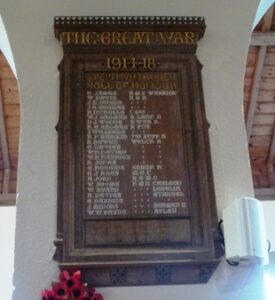
Harold Picton Bamkin, Second Lieutenant, Suffolk Regiment. Harold was born on 10 November 1895, the son of Ernest Picton Bamkin and Lilian Margaret Bamkin, of Thornton Hall, Milford Haven. He was educated at Dulwich College, and had entered Jesus College, Oxford prior to the outbreak of war, but instead joined the Inns of Court Officer Training Corps, before gaining a commission into the 7th Battalion, Suffolk Regiment in September 1914. The battalion became attached to 35 Brigade, 12th (Eastern) Division, which landed at Boulogne on 31 May 1915, and took over the line at Ploegsteert Wood. They remained here over the coming months, and it was while here, on 19 July 1915, that Harold was killed whilst attempting to rescue one of his men from No Mans Land. Harold was 20 years old, and is buried at Calvaire (Essex) Military Cemetery, near Ploegsteert, Belgium.
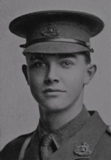
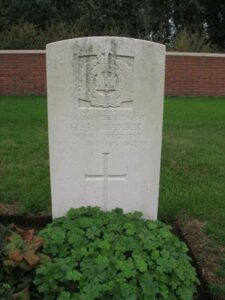
Stanley Thomas Bowen, Sergeant, 11, Welsh Regiment. Stanley was the only son of Alfred and Hannah Bowen, of Prendergast, Haverfordwest, and was the husband of Gertrude Clarke. He enlisted at Haverfordwest into the 4th Welsh prior to the outbreak of war, and by the outbreak had been promoted Sergeant. The battalion formed part of the Territorial Force, and was reformed for war in August 1914, becoming attached to 259 Brigade, 53rd (Welsh) Division. The Division moved to the Mediterranean, sailing from Devonport in July, 1915 arriving at Mudros by 5 August 1915. From here they moved to Gallipoli, landing on 9 August. Here the division was immediately thrown into action, and spent the next few days in isolated pockets, fighting against a Turkish counter-attack during the Battle of Sari Bair, and then at the Attack on Scimitar Hill. Stanley was one of several hundred casualties within the 4th Welsh during these first few days on Gallipoli. He was killed in action on 10 August 1915 aged 29, and is commemorated on the Helles Memorial. His widow later remarried, and became Gertrude M. McNeill, of Erindale, Ontario, Canada.
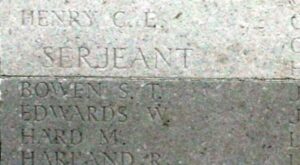
William Henry Broome, Engineman, 83ES, Royal Naval Reserve. William was born on 20 November 1885, the son of Mary Elizabeth Broome. He married in 1908, and lived with his wife Annie Jane Broome, at 219, Robert Street, Milford Haven. For some unknown reason he served with the Royal Naval Reserve as William Thomas, as Engineman aboard HM Trawler Carlton. William was killed on 21 February 1916 when Carlton struck a mine off Folkestone. He was 29 years old, and is commemorated on the Plymouth Naval Memorial, Devon.
Walter Henry Byard, Deck Hand, 2909DA, Royal Naval Reserve. Walter was born at Gloucester on 27 June 1884. During the war he lived with his wife Alice Byard, at Priory Village, Milford Haven. Walter served as Deck Hand aboard HM Trawler Lobelia II, and was killed when she struck a mine and sank off Lough Swilly on 19 April 1917. Walter was 32 years old, and is commemorated on the Plymouth Naval Memorial, Devon.
Albert Davies, Trimmer, 6189TS, Royal Naval Reserve. Albert was born on 19 October 1876, the son of William and Mary Davies, of Hakin. He lived with his wife Esther Davies, at Lower Thornton, Milford Haven. Albert served aboard HM Trawler Evangel, and was killed when Evangel was sunk by a mine explosion in the English Channel on 25 March 1917. Albert was 39 years old, and is commemorated on the Plymouth Naval Memorial, Devon.
Thomas Davies, Private, 52888, Welsh Regiment. Thomas was born at Steynton in 1894, the son of John and Elizabeth Davies. He married prior to embarking for war, and his wife E. M. Davies resided at Primrose Cottage, Woodson, Milford Haven. Thomas enlisted at Cardiff into the army, joining the 11th Battalion, Welsh Regiment, which was known as the Cardiff Pals battalion, attached to 67 Brigade, 22nd Division. The Division crossed to France in early September 1915, with all units being concentrated near Flesselles by 9 September, but on 27 October 1915 the Division, embarked for Salonika from Marseilles. It completed concentration there in November, and took part in the Retreat from Serbia during December 1915. During August 1916 the division fought at the battle of Horseshoe Hill, and the following month fought at the battle of Machukovo. During the end of April and 9 May 1917 the Division fought at the battle of Doiran. Thomas took ill and died in Salonika on 13 September 1917, aged 23. He is buried at Kirechkoi-Hortakoi Military Cemetery, Salonika.
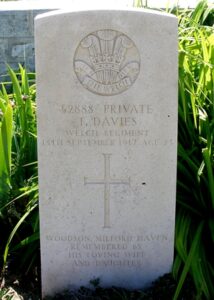
William Davies, Gunner, 447, Royal Garrison Artillery. William was the son of William and Ellen Davies, of Upper Road, Thornton, Milford Haven. He had enlisted at Milford into the Royal Garrison Artillery, joining their newly formed 68th Siege Battery, based at Hubberston, and moved to France with the battery in 1916. Williams’ time in France was to be short however, as he was killed at Arras on 25 May 1916. William was 22 years old, and is buried at Fauborg D’Amiens Cemetery, Arras, France.
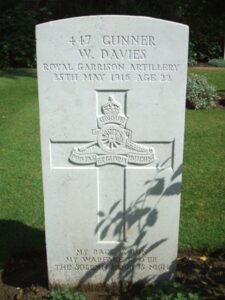
William Henry Thomas Davies, Private, 54489, Welsh Regiment. William was the son of Robert Septimus Davies and Emma Davies (nee Phillips), of Dale Road, Steynton. He enlisted there into the army, and was posted to France late in 1916 to join the 15th Battalion, Welsh Regiment, the Carmarthen Pals battalion. The battalion had been in France since December 1915 attached to 114 Brigade, 38th (Welsh) Division, and had taken part in the capture of Mametz Wood in July 1916, before moving via Hebuterne to Boesinghe, north of Ypres. On 31 July 1917 the 15th Welsh took part in the assault on Pilckem Ridge, successfully capturing their objectives. During the following days, the battalion remained in the front line, and played a part in the Battle of Langemarck. After a winter near Armentieres, in April 1918 the Division was moved to positions near Aveluy Wood on the Somme, where it remained until it crossed the River Ancre from 21 August 1918 onwards, and successfully captured Thiepval and Pozieres Ridges over the coming days. The Welshmen then advanced over the old Somme battlefields of 1916, capturing Longueval and Delville Wood, before taking part in the Battle of Morval and subsequently the advance towards Saily-Saillisel. William was killed at Sailly on 4 September 1918, aged 25. He is buried at Sailly-Saillisel British Cemetery, France.
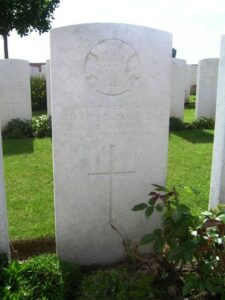
Ernest James Harding, Deck Hand, 2958TS, Royal Naval Reserve. Ernest was born on 19 January 1897, the son of Ernest and Catherine Harding, of 12, Marble Hall, Milford Haven. He served as Deck Hand aboard HM Trawler Evangel, and was drowned when she was lost following a mine explosion in the English Channel on 25 March 1917, aged 20. Ernest is commemorated on the Plymouth Naval Memorial, Devon.
William Harries, Private, 201569, Welsh Regiment. William was born at Steynton in 1889. He was the stepson of James and Mary Jones, of Bullford, Johnston. William enlisted at Haverfordwest into the Welsh Regiment. William was posted to France, where he joined the 1/6th Battalion, Welsh Regiment, the Pioneer battalion to the 1st Division. The Division had been in France since the outbreak of war, and had fought at every major battle thereafter. They followed the German retreat to the Hindenburg Line in early 1917, and were then briefed for an operation on the Flanders Coast, and moved there during the summer of 1917. While training on the coast, the Battle of Third Ypres had stalled in the mire, and the Division were recalled to Ypres, where they fought at the Second Battle of Passchendaele. William was killed here on 12 November 1917, aged 28. He has no known grave, and is commemorated on the Tyne Cot Memorial, Belgium.
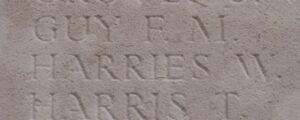
Edward Hoggins, Private, 7180, Kings Shropshire Light Infantry. Edward was born in Staffordshire in 1885, the son of John and Jane Hoggins. He was a regular soldier, and resided with his wife Rachel Ellen Hoggins, at 4, Castle Terrace, Milford Haven. Edward served with the 1st Battalion, King’s Shropshire Light Infantry, who were stationed at Tipperary at the outbreak of war, attached to 16 Brigade, 6th Division. On 10 September 1914 the Division landed at St Nazaire and proceeded to the Western Front, and arrived in time to reinforce the hard-pressed BEF on the Aisne, before the whole army was moved north into Flanders. Edward was killed soon after, on 24 October 1914. He was 29 years old, and is commemorated on the Ploegsteert Memorial, Belgium.
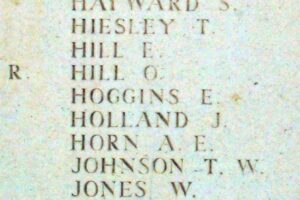
Thomas James, Leading Stoker, 292153, Royal Navy. Thomas was born on 25 January 1878. He was the Husband of Sarah James, of Blackbridge, Milford Haven, and served aboard HMS Warrior. She was a Duke of Edinburgh Class armoured cruiser, which had been built at Pembroke Dockyards. She joined the Grand Fleet at the outbreak of war, as part of the 1st cruiser Squadron, and took part in the greatest naval battle of all time, the Battle of Jutland, on 31 May 1916. Warrior played a brave part in the battle, but was worn down by heavy German fire. Many of her crew were killed during the battle, but for a while she remained afloat, being taken under tow by HMS Engadine. She sank the following day, with 743 of her crew having been rescued. Thomas was one of the unlucky ones however. He was killed on 31 May 1916 aged 38, and is commemorated on the Plymouth Naval Memorial, Devon.
William Arthur John, Private, 79940, Royal Army Medical Corps. William was the son of William and Elizabeth John, of 6, Lower Cromwell Terrace, Priory, Milford Haven. He enlisted at Milford into the Royal Army Medical Corps on 11 December 1915. William served in Britain until being passed fit for overseas service in August 1916, and was posted to the Far East. William arrived at Alexandria in October 1916, then sailed via Suez to Bombay, before being posted to Basra. Little else is known of William, but he died was invalided to India, and died at Deccan War Hospital, Poona on 10 October 1918 aged 22. William is commemorated on the Kirkee 1914-1918 Memorial, India.
James Hubert Jones, Private, 201598, Welsh Regiment. Hubert was born at Steynton, and was the Nephew of Mrs. Elizabeth Hughes, of Denant Hill, Haverfordwest. He had enlisted at a recruitment drive at Talbenny into the Welsh Regiment, and was posted to France to join the 1/6th Battalion, Welsh Regiment, the Pioneer battalion to the 1st Division. The Division had been in France since the outbreak of war, and had fought at every major battle thereafter. They followed the German retreat to the Hindenburg Line in early 1917, and were then briefed for an operation on the Flanders Coast, and moved there during the summer of 1917. While training on the coast, the Battle of Third Ypres had stalled in the mire, and the Division were recalled to Ypres, where they fought at the Second Battle of Passchendaele. After spending another Winter in Flanders, they were near Estaires when the German Spring Offensive caught them, fighting through the Battles of Estaires, Hazebrouck, and Bethune before being moved South again to Arras, fighting at the Battle of Drocourt-Queant, and at the Battle of Épehy, after the tide had been turned in the favour of the Allies. The Division pushed on towards the St. Quentin Canal. Hubert was killed around this time, on 16 September 1918. He was 24 years old, and is buried at Vermand Communal Cemetery, France.
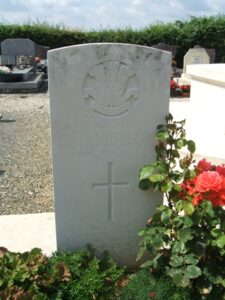
William Henry Miners, Skipper, 101SA, Royal Naval Reserve. William was born in Cornwall in 1882, the son of William and Alice Miners. He had lived at Milford for many years prior to the war, working as a fisherman, and had married Caroline Edwards in 1908, residing with his wife at 2, Marble Hall, Milford Haven. He served in the Merchant Fleet, but was attached to the Royal Naval Reserve, as Skipper aboard HM Trawler Norman II, which was taken over by the Admiralty in 1915 for use as a Minesweeper. William died at Stonehouse Naval Hospital, Plymouth on 18 April 1918, aged 35. It is unknown if it was as a result of active service, and is buried at Ford Park Cemetery, Devon.
Richard Nichols, Private, 1822, Irish Guards. Richard was the son of George and Ellen Nichols, of Plymouth. He had worked at Milford Docks for several years prior to the war, residing at 25, Dartmouth Gardens, Milford Haven. Richard travelled to Waterford to enlist into the Irish Guards. At the outbreak of war, Richard was with their 1st Battalion, attached to 4th (Guards) Brigade, 2nd Division. One of the first Divisions to move to France, the 2nd Division remained on the Western Front throughout the war. They moved to Belgium, where they fought at the Battle of Mons, and retreating southwards, fought at the Affair of Landrecies, the Rearguard Actions of Villers-Cotterets, and at the Battle of the Marne where the German offensive was stopped. The Germans retreated north, and the BEF met them, fighting at the Battle of the Aisne. The 2nd Division were then moved to Flanders, where they fought at the First Battle of Ypres, when the German sweep through Flanders was stopped. Richard was killed at Ypres on 26 October 1914, aged 29. He is commemorated on the Ypres (Menin Gate) Memorial, Belgium.
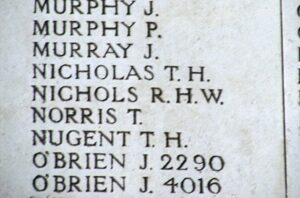
James Owen, Gunner, 371069, Royal Garrison Artillery. James was born at Steynton, and enlisted at Milford into the Royal Garrison Artillery, joining their 68th Siege Battery. The Battery landed in France on 31 March 1916, and took part in the Somme Battles, before moving to the Arras Sector. James was killed during the Battle of Arras on 30 April 1917. He is buried at Ste. Catherine British Cemetery, France.
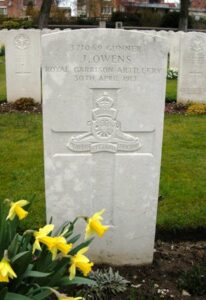
William Walter Payne, Engineman, 331ES, Royal Naval Reserve. William was born on 21 April 1881, the son of Frank Payne, of Bristol. He married Edith Matilda Owens in 1906, and the couple resided at 5, Priory Terrace, Milford Haven, with their three children. William was serving as Engineman aboard HM Trawler Apley, when she struck a mine off the Isle of Wight on 6 December 1917 and sank with all hands. William was 35 years old and is commemorated on the Plymouth Naval Memorial, Devon.
Thomas John Rees, Private, 31278, Machine Gun Corps. Thomas was the son of Thomas and Margaret Rees, of Meadow Villa, Tregaron. He originally enlisted at Lampeter on 9 December 1915 into the South Wales Borderers, but was transferred to the Machine Gun Corps on 11 April 1916. Thomas didn’t serve overseas, but became ill with tuberculosis, and died at Bilton Park Military Hospital on 8 May 1917. He was 22 years old, and is buried at Tregaron (Bwlchgwynt) Calvinistic Methodist Chapelyard. No links to Steynton have been traced, but this is the only man to match the details on the memorial.
James Henry (Harry) Thomas, Lance Corporal, 17430, Royal Fusiliers. Harry was born at St Davids, the son of Dorothy Thomas. His father died when he was young, and Dorothy married William Orchard in 1899. The family moved to 1, Priory Hill, Milford Haven, where Dorothy gave birth to several other children, and Harry was raised as William’s own son. He enlisted at Haverfordwest into the Army, and was posted to France at some time in 1916, joining the 1st Battalion, Royal Fusiliers, which was attached to 17 Brigade, 6th Division. Harry probably saw his first action on the Somme, at the Battle of Flers-Courcelette, the Battle of Morval and the Battle of Le Transloy. The following year saw the division at Arras, where it fought at the Battle of Hill 70, and then during the Battle of Cambrai later in the year. In the spring of 1918 the Division was one of those hit by the German Offensive on the Somme, which had been launched on 21 March, and the Division took part in the Battle of St Quentin. Harry was killed during the build up to the German offensive, on 8 March 1918, aged 23. He is buried at Tincourt New British Cemetery, France.
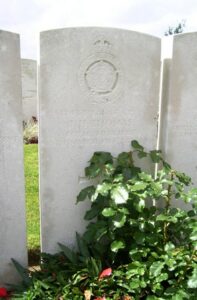
James George Thomas, Bombardier, 371331, Royal Garrison Artillery. James was the son of John and Elizabeth Thomas, of Fair View, Priory Hill, Milford Haven. He enlisted at Milford into the Pembrokeshire Battery, Royal Garrison Artillery. James joined its 11th Siege Battery, and moved to France on 21 April 1915. James probably served through the Battles of Loos, and at the Somme in 1916, before being killed during the Battle of Arras on 24 May 1917. He has no known grave, and is commemorated on the Arras Memorial, France.
William Thomas, Private, 19778, Loyal North Lancashire Regiment. William was born at Steynton. He enlisted at Cardiff into the Welsh Regiment, but was later transferred into the 6th Battalion, Loyal North Lancashire Regiment, which was attached to 38 Brigade, 13th (Western) Division. Towards the end of February the Division concentrated at Blackdown in Hampshire, and on 13 June 1915 the first transports carrying the Division left port, moving to Alexandria. By 4 July, all units had moved to Mudros, preparatory for landing on Gallipoli, and between 6 and 16 July 1915 the Division landed on Cape Helles, relieving the 29th Division. They left and returned to Mudros at the end of the month, and the entire Division landed at ANZAC Cove between 3 and 5 August 1915, taking part in the Battle of Sari Bair. William was killed here on 9 August 1915, aged 25. He has no known grave, and is commemorated on the Helles Memorial, Gallipoli.
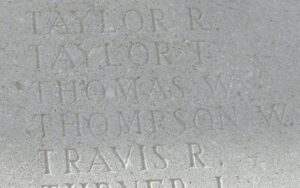
John Williams, Private, 26566, Royal Fusiliers. John was born at Abercastle, Mathry in 1892. For several years prior to the war, he had resided with his Uncle and Aunt, Lori and Mary Adams, at 3, Coombs, Milford Haven. John enlisted at Milford into the Army, and was posted to the 8th Battalion, Royal Fusiliers, which were attached to 36 Brigade, 12th (Eastern) Division. The Division landed at Boulogne on 31 May 1915, and took over the line at Ploegsteert Wood. They then moved south and fought in the Battle of Loos, and the subsequent actions of the Hohenzollern Redoubt, and remained there until March 1916. By June they were in position at the Somme, and attacked Ovillers on 2 July. They fought at Pozieres and Le Transloy, which is where John was badly wounded. He was evacuated to the military hospital at Boulogne for treatment, but sadly died of his wounds there on 7 October 1916, aged 24. John is buried at Boulogne Eastern Cemetery, France.
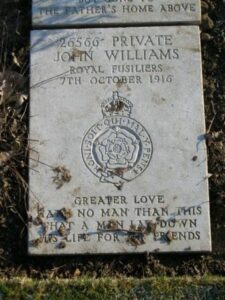
David Joseph Wood, Private, 267198, Royal Warwickshire Regiment. David was born in 1893, the son of Richard and Sarah Ann Wood, of 29, Newgate Street, Llanfaes, Brecon. He worked as a miner prior to enlisting at Wrexham in March 1914 into the 3rd Battalion, South Wales Borderers. David was discharged at Pembroke on 23 October 1914 as being medically unfit. He married Ellen Thomas early in 1915, and the couple resided at Fern Cottage, Johnston. David re-enlisted at Milford into the Welsh Regiment, and was one of several local men posted to the 2/7th Battalion, Royal Warwickshire Regiment, part of 182 Brigade, 61st (2nd South Midland) Division. The Division had been in France since 21 May 1916, moving to positions at Fromelles, where it was virtually decimated. Such was the damage to the Division that it was not used again other than for holding trench lines until 1917, when it followed the German withdrawal to the Hindenburg Line, capturing Chaulnes and Bapaume. Later that year it fought at Battle of Langemarck, as part of the Third Battle of Ypres, and in late August and early September it was involved in the efforts to push the line forward at positions around Schuler Farm and Aisne Farm near Kerselaar. The Division then moved south, where it was to take part in the Battle of Cambrai. 61st Division was initially held in reserve and was still in the area when the enemy made a determined counterattack on 30 November. The Division was ordered up to reinforce the units under attack in the area of La Vacquerie and for some days was involved in a hard fight to stem the enemy attack. During March, 1918 the Division was holding the forward zone of defences in the sector northwest of Saint Quentin, in the area of Ham and lost many men as it fought a chaotic but ultimately successful withdrawal back over the Somme crossings over the next ten days. David was one of many men lost in the first days of this terrible fighting. He was killed in action on 22 March 1918, aged 25, and is commemorated on the Pozières Memorial, France.
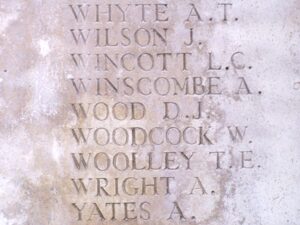
World War Two, 1939-1945
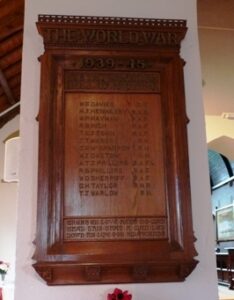
William Edward Davies, Chief Petty Officer, D/JX 143493, Royal Navy. William was the son of Mr. and Mrs. W. Davies, of Steynton. He served with the Royal Navy aboard HMS Whitaker. She had originally been built at Ingham, Massachusetts for the US Navy, but on 28 January 1944 was commissioned as frigate HMS Whitaker in the Royal Navy under the lend-lease scheme. Early in the morning of 1 November 1944, U-483 fired two FAT torpedoes at the convoy SC-159 off Matlin Head. The submariners heard two detonations and sinking noises and claimed hits on two steamers. In fact one of the ships hit was HMS Whitaker, which had lost the whole bow forward of the bridge due to the explosion of the forward magazine. The commander, all seven officers and 84 ratings were lost. Some wounded survivors were rescued. Over the next two hours, remaining members of her crew extinguished the fires and stopped the flooding of the vessel, which was then towed to Londonderry and later to Belfast. William was one of the unfortunate men killed in the explosion on 1 November 1944. He was 26 years old, and is commemorated on the Plymouth Naval Memorial, Devon.
William Peter Hayman, Sergeant, 1584209, Royal Air Force Volunteer Reserve. William was the son of Frank James Hayman and Elsie Gertrude Hayman (nee Griffiths), of Tenby. He served with 185 Squadron, Royal Air Force, which was based in the Mediterranean, equipped with the Supermarine Spitfire. At the beginning of 1945 the Squadron was based at Villafranca, Italy, and it was here that William was killed on 4 April 1945. He was 22 years old and is commemorated on the Malta Memorial, Malta.
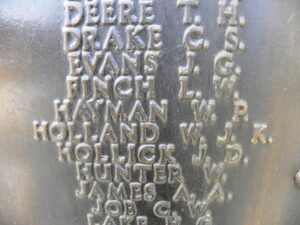
Michael Joseph Hennessy, Leading Seaman, LT/JX. 224445, Royal Naval Patrol Service. Michael was the son of James and Ellen Hennessy, of New Cross, Ireland. He married Annie Elizabeth Hicks of Milford Haven whilst working there as a fisherman. He served aboard HM Motor Minesweeper 38. She had been attacked and sunk on 18 August 1942 in the English Channel. Michael survived the sinking and was on leave in Swansea when he was killed in an air raid on 16 February 1943. He was 35 years old and is buried at Milford Haven Cemetery.
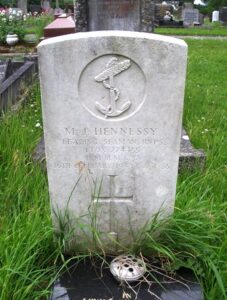
Robert Benjamin High, Leading Aircraftman (Pilot U/T), 967883, Royal Air Force Volunteer Reserve. Robert was the son of Reginald Robert High and Myrtle High (nee Blockwell), of Milford Haven. He trained as a Pilot with No 2 Flying Training School at RAF Brize Norton. On 20 September 1940 Robert was carrying out a blind flying exercise in Oxford P9039 when it collided with Avro Anson N9821 of No 6 Flying Training School, and crashed in a field North of Great Barington. The occupants of both aircraft were all killed. Robert was 21 years old when he died that day and is buried at Milford Haven Cemetery.
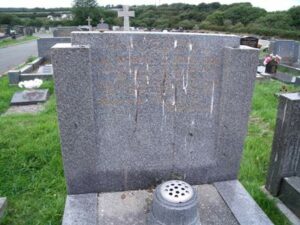
Thomas Elmor James John, Leading Aircraftman, 976947, Royal Air Force Volunteer Reserve. Thomas was the son of George John and Sarah Ann John (nee Williams), of Steynton. He served with the Royal Air Force in the Far East. Little else is known of Thomas, but he died in India on 27 September 1945. He was 23 years old, and is buried at Delhi War Cemetery, India.
James Thomas Mason, Able Seaman, C/JX 185146, Royal Navy. James was the son of William John and Annie Jane Mason, of Haverfordwest. He served with the Royal Navy aboard HMS Avenger. Avenger was originally laid down as a merchant ship at Chester, Pennsylvania, but was converted to an aircraft carrier for the Royal Navy under the lend-lease scheme. She had a complement of 12 Sea Hurricane’s and three Fairey Swordfish. In September 1942, she took part in a large Russian convoy, and upon her return home, her captain drew up recommendations for future escort carrier design, after spotting several flaws in her design. In November 1942 she took part in Operation Torch, the Allied invasion of North Africa, where she suffered engine problems. While leaving North Africa to start the journey home Avenger was sunk by the U-155 as she was nearing Gibraltar on 15 November 1942, with a heavy loss of life among her crew. James was one of the men killed. He was 24 years old, and is commemorated on the Chatham Naval Memorial, Kent.
John Richard McSparron, Petty Officer, D/JX 141250, Royal Navy. John was born at Steynton on 26 November 1917, the son of John Joseph McSparron and Adelaide Florence Maybeline McSparron (nee Howells). He enlisted into the Royal Navy and served with the Royal Navy aboard HMS Prince of Wales. Prince of Wales was a modern King George V-class battleship. She was heavily involved in the first contact with the German battleship Bismarck and the cruiser Prinz Eugen, and was the ship that landed the hit on the Bismarck that caused her to return to port, a decision which ultimately led to her loss. Prince of Wales suffered heavy damage during the engagement and returned to Rosyth for repairs. On 25 October 1941 Prince of Wales departed for Singapore and on 2 December 1941 the ship docked in Singapore along with the rest of Force Z. Early in the morning of 10 December 1941 Force Z was sent to investigate reports of Japanese landing forces at Juantyan. The reports proved to be false, but Force Z was discovered by Japanese bombers and torpedo planes which attacked the fleet. At around 11.30 torpedoes struck Prince of Wales, badly damaging her, then HMS Repulse was sank an hour later. Another group of aircraft attacked the stricken Prince of Wales, and at 13.20 she sank, with the loss of 327 men including John. John was 24 years old, and is commemorated on the Plymouth Naval Memorial, Devon.
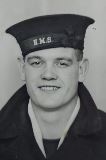
William John Owston, Deck Hand, Fishing Fleet. William was the son of Ambrose Owston and Minnie Owston (nee James), of 44, St Anne’s Road, Hakin, Milford Haven. He served with the Fishing Fleet aboard the Fishing Vessel Respondo, which was registered in West Hartlepool, but based at Milford. William was drowned when Respondo was lost off Milford Haven on 11 September 1940. He was 33 years old, and is commemorated on the Tower Hill Memorial, London.
Alwyn Thomas John Phillips, Pilot Officer (Air Bomber), 137542, Royal Air Force Volunteer Reserve. Alwyn was the son of John Howell Phillips and Martha Elizabeth Phillips, of Tiers Cross. He married Stella Adrienne Pugh, of Hatch End, Pinner, Middlesex in 1941. He was training as an Air Bomber with the Royal Air Force when he was killed during an aeroplane crash in Caernavonshire while flying aboard Avro Anson I, Serial EG129 of No. 9 Observers Advanced Flying Unit which crashed after experiencing difficulties on 1 March 1943. Alwyn was 33 years old, and is buried at Tiers Cross Congregational Cemetery.
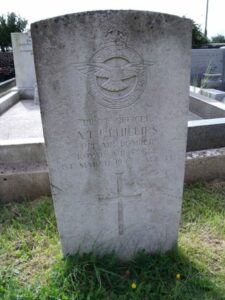
Robert Stanley Phillips, Aircraftman 1st Class, 1413590, Royal Air Force Volunteer Reserve. Robert was the son of George Pasco Phillips and Helen Georgina Phillips, and the Husband of Catherine Phillips, of Milford Haven. He served during the war with the Royal Air Force Volunteer Reserve. Robert died just after the cessation of hostilities, on 30 November 1945. He was 39 years old, and is buried at Milford Haven Cemetery, Pembrokeshire.
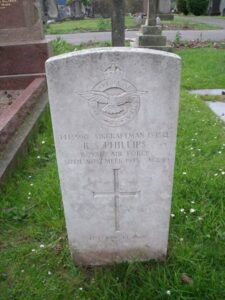
William David Sherriff, Flight Sergeant, 362166, Royal Air Force. William was the son of Horace W. and Elizabeth Sherriff of The Gables, Steynton Road, Milford Haven, and the husband of Violet Sherriff of Dunstable Beds. He served as ground crew with 72 Squadron, Royal Air Force. William was in France attached to the BEF when he was posted as missing in action on 27 June 1940, during the BEF’s retreat to Dunkirk. William was later posted as Missing in Action, believed Killed in Action, after an official enquiry on 25 September 1941. After the evacuation from Dunkirk a former comrade of William’s wrote to his parents to tell them that William had died when his lorry struck a land mine in France and exploded. William was 34 years old, and is commemorated on the Runnymede Memorial, Surrey.
Charles Henry Taylor, Seaman, LT/X 21666A, Royal Naval Reserve (Patrol Service). Charles was the son of Charles Henry Taylor and Olive Taylor (nee Field), of Steynton. He served with the Royal Naval Reserve. He was posted to the Royal Naval Patrol Service, and served aboard H.M. Trawler Pyrope, which had been converted by the Admiralty for use in anti submarine operations. Charles lost his life when Pyrope was lost on 12 August 1940 in the Thames estuary due to German air attack. He was 19 years old and is commemorated on the Lowestoft Naval Memorial, Suffolk.
Thomas George John Warlow, Stoker, LT/KX 109957, Royal Naval Patrol Service. Thomas was the son of Thomas and Alice Warlow of Steynton. He married Sarah Ellen Thomas of Tier’s Cross in 1937. He served aboard HM Trawler Almond, which was a Tree class admiralty trawler, taken into service May 1940 as a minesweeper. Thomas died when Almond was sunk by a mine off Falmouth on 2 February 1941. He was 28 years old, and is commemorated on the Lowestoft Naval Memorial.